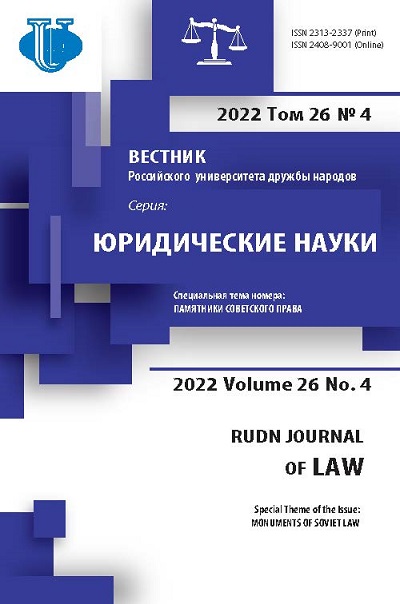The Soviet Union as a composite state structure: education, development trends and causes of disintegration
- Authors: Eremyan V.V.1
-
Affiliations:
- Peoples’ Friendship University of Russia (RUDN University)
- Issue: Vol 26, No 4 (2022): MONUMENTS OF SOVIET LAW
- Pages: 747-807
- Section: THE SOVIET UNION IN RETROSPECTIVE OF MODERN LEGAL SCIENCE
- URL: https://journals.rudn.ru/law/article/view/32969
- DOI: https://doi.org/10.22363/2313-2337-2022-26-4-747-807
- ID: 32969
Cite item
Full Text
Abstract
This article is devoted to a critical comparative-legal analysis of the process of formation, development, transformation and disintegration of the first multinational political-territorial entity with a republican form of government of the “Soviet” type, which over time has become a clear example for such complex European states as Yugoslavia and Czechoslovakia. This theme is unique not only in terms of solving the ethnic issue, but also as the “model” of territorial structure since the basis of one federation, the Union of Soviet Socialist Republics, formed another federation, the Russian Soviet Federative Socialist Republic, which integrated, along with traditional administrative units, national political-territorial entities in the form of autonomous republics, regions, and districts. The article emphasizes the fact that one of the consequences of the appearance on the political map of the Soviet Union, which defeated Nazi Germany and its numerous satellites in World War II, was not only the formation of “popular democracy” countries and the so-called “socialist camp” that existed for over forty years and represented a civilizational alternative to the capitalist path of social development, but also the collapse of the colonial system and acquisition of independence and sovereignty by the peoples inhabiting the regions of Africa, Asia, and the Middle East. The Soviet model of the state structure and democracy institutions as antipodes to bourgeois populism and liberal demagogy facilitated an accelerated transition from declarations of constituent and constitutional documents proclaiming human and civil rights and freedoms to their practical implementation in the economic and political sphere in countries that had associated themselves with Western-style democracy; it resulted in a more socially oriented role of state and its structures. The Soviet experience clearly demonstrates what real results the state and society can achieve in solving the women's issue, elimination of total illiteracy, and growth of the well-being of citizens. At the same time, manifestations of authoritarianism and totalitarianism that took place at certain stages reveal that the power mechanism was subject not only to voluntaristic tendencies or official personification, but also to relapses into a personality cult, one of the most negative consequences of state disintegration and local civil wars within its former territory.
About the authors
Vitaliy V. Eremyan
Peoples’ Friendship University of Russia (RUDN University)
Author for correspondence.
Email: v.v.eremyan@yandex.ru
ORCID iD: 0000-0001-6271-4568
Doctor of Legal Sciences, Full Professor, Head of the Department of Constitutional Law and Constitutional Procedure, Law Institute
6 Miklukho-Maklaya str., Moscow, 117198, Russian FederationReferences
- Chirkin, V.E. (1999) Constitutional law of foreign countries. Moscow, Yurist Publ. (in Russian).
- Dubrovin, V.N. (ed.) (2003) Constitutions of foreign countries. Moscow, Yurlitinform Publ. (in Russian).
- Ebzeev, B.S. (2019) Constitutional law of Russia: textbook. Moscow, Prospect Publ. (in Russian).
- Eremyan, V.V. (ed.) (2017) Constitutional (state) law of foreign countries: textbook for students of jurisprudence. Moscow, UNITY-DANA Publ. (in Russian).
- Farberov, N.P. (ed.) (1986) State law of the USSR and Soviet construction: textbook. Moscow, Yuridicheskaya literature Publ. (in Russian).
- Kabyshev, V.T. & Zametina, T.V. (2016) Russia-Crimea-Sevastopol: constitutional and legal research. Moscow, Gorodets Publ. (in Russian).
- Khabrieva, T.Ja. (ed.) (2006) Constitutions of the States of America: in 3 t. T. 1: North and Central America. Moscow, Institute of Legislation and Comparative Law under the Government of the Russian Federation. (in Russian).
- Krasheninnikova, N.A. (ed.) (2000) A textbook on the history of state and law of foreign countries. Moscow, ZERTsALO Publ. (in Russian).
- Mishin, A.A. (1976) State law of the United States. Moscow, Nauka Publ. (in Russian).
- Okun’kov, L.A. (ed.) (1997) Constitutions of the European Union states. Moscow, INFRA-M NORMA Publ. (in Russian).
- Shamba, T.M. & Neproshin, A.Ju. (2005) Abkhazia: legal basis of statehood and sovereignty. Moscow, OOO In-Octavo. (in Russian).
- Titov, Ju.P. (1998) The anthology of the history of the state and law of Russia. Moscow, Prospect Publ. (in Russian).
Supplementary files















